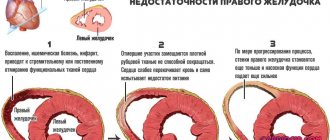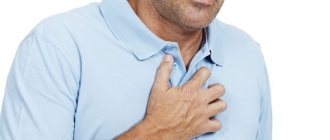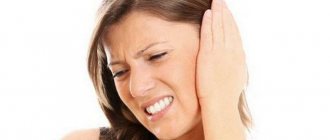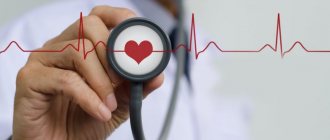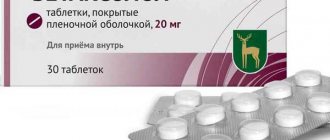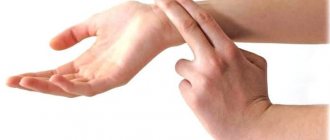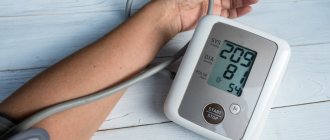- Relationship between tachycardia and high blood pressure
- Causes of tachycardia (with high blood pressure)
- Symptoms
- Dangerous or not?
- Treatment and symptom management
- Forecasts
- Prevention
Rapid heartbeat with high blood pressure occurs due to forced pumping of blood in slightly larger volumes than expected. The heart becomes overloaded and other pathologies begin to develop. Often, hypertensive patients suffer from arrhythmia, when the heart beats unevenly.
Relationship between tachycardia and high blood pressure
Tachycardia and high blood pressure are not related to each other, one does not provoke the other, but they can appear simultaneously. Hypertension occurs when the heartbeat rhythm is disturbed due to increased stress on the heart muscle. Overload, in turn, causes changes in heart rate. Tachycardia is a heart rhythm disorder caused by stress and an unhealthy lifestyle. If tachycardia is also recorded with increased pressure, this indicates that other regulatory mechanisms of the body are also activated.
Physical activity also increases palpitations; if such processes occur constantly, the pressure begins to increase periodically, since it takes additional time to fill the ventricles of the heart with blood. And gradually the high blood pressure syndrome becomes permanent.
Tablets for low blood pressure
There are 4 groups of pharmacological drugs.
The first are sedatives , the purpose of which is to normalize the nervous system and lower the heart rate (Persen, Motherwort, Novo-Passit). Consisting of medicinal herbs, they do not pose any harm to the body.
Antiarrhythmic drugs help normalize heart rhythm. Their use has some contraindications, so the use of these drugs is possible only under the supervision of a doctor - “Adenosine”, “Verapamil”, “Nibentan”.
Beta blockers are aimed at reducing to a minimum level the influence of those hormones that provoke stress, as a result of which tachycardia develops: “Coronal”, “Binelol”, “Concor”.
Cardiac glucosites are prescribed if the patient has heart failure. “Adonizide”, “Gerbion”, “Celanid” increase the tone of the heart vessels and muscles.
Causes of tachycardia (with high blood pressure)
Tachycardia and hypertension may indicate the presence of a disease such as pheochromocytoma. This tumor produces adrenaline and is accompanied by severe headaches.
At the same time, an increase in blood pressure and pulse occurs in the following cases:
- stress;
- great physical activity;
- consumption of alcohol, fatty foods;
- excessive passion for strong tea and coffee.
Other diseases and processes can also provoke tachycardia with high blood pressure:
- bleeding;
- dehydration;
- anemia;
- leukemia;
- heart disease;
- myocarditis;
- thyroid diseases;
- menopause
Sometimes tachycardia becomes a side effect of certain heart medications.
How are tachycardia and hypertension related?
Tachycardia and heart attack are dangerous diseases that have negative consequences. Cardiologists call rapid heartbeat tachycardia. This condition is usually caused by certain illnesses or physiological factors. You should know that tachycardia is considered an independent disease.
Generally, this disease can occur in people under certain conditions. At the same time, tachycardia can be a sign of many other ailments in the human body. Therefore, if it occurs, you must immediately consult a doctor who can make a correct diagnosis. In addition, it is important to remember that various types of tachycardia can be triggered by heart problems and thus pose a significant danger to human health and life.
First of all, tachycardia is a rapid heartbeat, more than 90 beats per minute. If the heartbeat quickens during emotional or physical stress, then this condition is considered normal for the human body. The main signs of the onset of tachycardia are:
- the occurrence of frequent dizziness;
- loss of consciousness (fainting);
- feeling of strong pulsation in the neck;
- rapid heartbeat.
As stated at the beginning, tachycardia is both an independent disease and a symptom of a disease. However, it should be emphasized that a rapid heartbeat can contribute to the development of such serious problems as cardiac arrest, the development of acute heart failure, coronary heart disease and myocardial infarction (MI).
There is no mechanism in the human body that can simultaneously regulate blood pressure and the number of myocardial contractions. The third reflexogenic zone is responsible for the pulse rate, irritation of which leads to an increase in the rhythm of heart contractions, but not an increase in pressure. Pulse pressure regulates the cardiomotor center of the medulla oblongata, which influences the systological volume of the heart, but it has no connection with the third reflexogenic zone.
Increased heart rate with high blood pressure occurs due to the need to pump a larger volume of blood than usual. In this case, the heart experiences heavy loads, which causes negative consequences in it, including left ventricular hypertrophy. Tachycardia is quite capable of developing during a hypertensive crisis, creating the danger of ventricular failure or fibrillation.
Symptoms
Against the background of hypertension, any type of arrhythmia can develop, which can lead to heart failure. Doctors consider the symptoms of manifestation, depending on the types of tachycardia.
- Sinus . The heart rhythm reaches 100 beats per minute, with a maximum of 180. It occurs after heavy exertion or a nervous shock; a rhythm disturbance can also be caused by depression, neurosis, or a panic attack. Performance deteriorates, the patient loses consciousness during attacks.
- Paroxysmal . The heartbeat increases suddenly, but also suddenly goes away. The contraction frequency can range from 130 to 240 beats per minute, but the rhythm remains correct.
There are 3 types of tachycardia:
- atrial;
- ventricular;
- atrioventricular.
Tachycardia in hypertension can be recognized by the following symptoms:
- headache throbbing in the temples and back of the head;
- severe weakness;
- shortness of breath, strong feeling of lack of air;
- dizziness;
- nausea;
- flushed face;
- confused thinking;
- feeling of pressure on the head and eyes.
The higher the pulse rate and pressure, the more pronounced the symptoms will be.
During treatment for bronchitis, blood pressure began to rise sharply
Tachycardia and high blood pressure are fairly common pathologies that are often diagnosed separately. But sometimes both diseases are combined, provoking the appearance of each other, mutually reinforcing the negative effect on the human body, and requiring immediate medical attention.
Tachycardia is a condition in which the pulse quickens to 90 or higher beats per minute (the norm is 60 - 80). The cause is usually cardiovascular disease, stress, and heavy physical activity. How to treat tachycardia accompanied by high blood pressure using folk remedies?
When the heart rate increases (with high and low pressure), shortness of breath, weakness, increased sweating, and chest pain are possible; when the heart rate is low (in hypotensive patients), dizziness and darkening of the eyes are possible.
Pulse and blood pressure are the main indicators of good health. Rare attacks of tachycardia occur in almost every person against the background of physical exertion and severe emotional shock. What to do if you often experience an elevated pulse with normal blood pressure - what could this condition indicate?
- Why does your heart rate rise?
- Pathological causes
- Symptoms
- How to treat
- How to reduce at home
- Rose hip
- Valerian
- Melissa
| Normal heart rate for men by age |
| Causes of low heart rate in an elderly person |
| Human pulse: normal table |
| Pulse 90: is it normal or not? |
Normally, the indicators fluctuate between 80–85 beats/min. In women the values are slightly higher, in older people – lower. In newborns, a high heart rate is normal. It gradually levels out by age 14–15.
Increased heart rate can be caused by harmless physiological reasons that should not cause concern:
- pregnancy – the heart has to work harder, which leads to an increase in heart rate to 100–110 beats/min;
- adolescence - during this period the size of the heart increases noticeably and the frequency of contractions increases;
- physical activity, hard work;
- drinking caffeinated drinks, overeating, spicy foods;
- strong positive and negative emotions.
Frequent and prolonged attacks of tachycardia occur against the background of various serious diseases. Most often, this condition is caused by prolonged stress, depression, and serious nervous disorders. In this case, the pressure may remain normal.
What diseases may a rapid pulse indicate:
- pathological changes in the myocardium;
- alcoholism, drug addiction;
- uncontrolled use of certain medications;
- anemia;
- hyperthyroidism – the disease is accompanied by sudden weight loss and nervousness;
- emphysema – lung tissue loses elasticity, which leads to increased heart rate;
- breathing disorder in children.
Tachycardia often occurs with obesity, vegetative-vascular dystonia, severe intoxication and serious infectious diseases.
Symptoms
The main manifestation of tachycardia is strong pulsation in the carotid or temporal artery. If the pulse is elevated due to physical activity or stress, the condition quickly returns to normal. If a rapid heart rate is accompanied by a general deterioration in well-being, you should consult a cardiologist or neurologist.
Signs of tachycardia:
- increased fatigue, weakness;
- it gets dark before your eyes, spots appear, and the clarity of the picture deteriorates;
- dizziness, lightheadedness, loss of consciousness;
- an obsessive hum appears in the ears;
- sweating increases, the person becomes either hot or cold.
Constantly racing heartbeat is an abnormal condition for a healthy person. Tachycardia does not go away on its own, which means it requires comprehensive diagnostics and competent drug therapy.
How to treat
Treatment of tachycardia consists of identifying and eliminating the disease that caused the increased heart rate. Primary diagnosis for increased heart rate consists of biochemical and hormonal blood tests, ECG, and ultrasound. Medicines alone are not enough to normalize the pulse. Often, the first thing doctors do is prescribe a therapeutic diet, which is aimed at cleansing the body of toxins and waste.
Shakes with high blood pressure due to spasms in the blood vessels. First of all, the symptom affects the facial muscles, then spreads throughout the body. This condition is accompanied by headache, darkening of the eyes, and increased temperature.
There are many reasons for chills. These include hypothermia, infectious pathologies, severe emotional shock, vegetative-vascular dystonia and a sharp jump in blood pressure to critical values.
In hypertensive patients, trembling in the body can be a harbinger of a hypertensive crisis. If you normalize your blood pressure, the chills go away and your health improves.
To lower blood pressure, medications are taken - Nifedipine and Captopril. They act within 30 minutes and quickly reduce levels. You can use emergency folk remedies - lotions with vinegar, massage of biologically active points.
There are many reasons why the whole body shakes with high blood pressure. Chills are a pronounced symptom that signals a malfunction in the body. It is often accompanied by general malaise, weakness, nausea, and drowsiness.
Hypothermia and infectious pathologies can lead to trembling in the body. Most often, they occur against the background of a deterioration in general health, but blood pressure remains within acceptable limits.
A very rare combination. Although the human body does not have a mechanism that jointly regulates both blood pressure and heart rate. The heart rate is controlled by the so-called third reflexogenic zone (the place where the vena cava flows into the right atrium), when irritated, it primarily causes an increase in heart rate, but not an increase in blood pressure.
Pulse pressure depends on the work of the cardiac motor center of the medulla oblongata, which affects the systolic volume of the heart and no nerve fibers from the so-called third reflexogenic zone approach it.
And if tachycardia is observed with an increase in blood pressure, then in this case other regulatory mechanisms by the body are already involved.
In general, during stress and physical work, the level of adrenaline in the blood increases sharply, thereby increasing the minimum or vascular blood pressure.
Adrenaline in the blood is gradually destroyed by special enzymes, and also, in the case of adequate physical work for the body, by endorphins. By the way, it has long been proven that A-cells of the pancreas also produce endorphin. It is worth noting that alcohol is a good adrenaline inhibitor. But this does not mean that you need to join it. However, it would be wrong not to know about this.
Any physical work performed increases your heart rate. And this is natural! Blood pressure should not increase because of this: the amount of blood that the heart pushes into the aorta will be exactly the same in volume both at a heart rate of 60 beats/min and at a heart rate of 160 beats/min, and the aorta has time to return to its original state, in which she remained before the contraction began. And this is logical!
But this doesn't happen forever. After 180 beats/min, with a decrease in heart rate, contrary to the laws of physiology, blood pressure begins to increase! In this case, the filling time of the ventricles of the heart increases.
If the physical activity was long-term and adequate for the body, then after it is completed, after 10-15 minutes, blood pressure begins to decrease even in “malignant” hypertensive patients.
This factor underlies the physical treatment of hypertension, which, like the medicinal factor, has every right to exist.
However, if the physical activity was too much for the body, then the person’s health condition may worsen: high blood pressure will remain elevated for a long time.
There will be no significant positive effect in the case of very low physical activity - protein synthesis of the heart muscle will lag behind its breakdown, which will ultimately lead to detraining and flabbiness of the entire myocardium.
Under stress, there is a sharp release of catecholamines, an increase in vascular and pulse blood pressure, an increase in skeletal muscle tone and a very long return to the original state.
Therefore, the mental factor is still considered the dominant cause of hypertension.
Dangerous or not?
A rapid pulse with hypertension is dangerous for blood vessels, since the load on them increases greatly. With increased pressure, the walls narrow and the heart muscle has difficulty pushing blood through.
This condition is fraught with complications:
- Cerebrovascular accident.
- Acute ventricular failure.
- Development of asthma.
- Arrhythmic shock.
- Kidney failure.
- Deterioration of vision.
- Erectile dysfunction in men.
This condition is very dangerous and can be fatal.
First aid
In case of a severe attack, when there are no medications at hand, the following manipulations can help:
- Take a deep breath, hold the air and tighten your chest area.
- Hold your face under running cold water for a few seconds.
- Press your palms onto your eyeballs several times.
First aid
If you notice a sudden increase in blood pressure and heart rate, do not panic, the first thing to do is call an ambulance.
Before the rapid response team arrives, you can give a person calming tea with lemon balm or mint at home.
It is important to open the windows to allow air flow, and also give the patient a Captopril tablet or other antihypertensive medication with emergency action.
Before figuring out what to drink if you have high blood pressure and high pulse, you need to provide first aid to the patient. It consists in optimizing conditions for normalizing the condition.
First aid:
- First of all, it is necessary to ensure optimal conditions for the victim’s breathing. To do this, you need to open the windows and free your body from tight clothing.
- This state shows peace. Therefore, the patient must either lie down on the bed or sit on furniture with back support.
- It is very important to try to calm down and normalize your breathing. To do this, you need to take a few deep breaths, you can count to yourself to ten.
- If there is a feeling of panic or the problem is caused by a stressful situation, then you can take a sedative. For example, tincture of valerian or Validol.
- It is necessary to keep your feet warm. To do this, you can use a heating pad, a bottle of warm liquid, or a woolen blanket. Some suggest using mustard plasters, but doctors do not recommend this.
- A light massage is necessary. To do this, you need to massage the sides of your neck and abdominal area with your fingers. You also need to press on the eyeballs.
- After this, you can take beta blockers. For example, Metoprolol.
- After half an hour, you need to recheck the indicators. If they are still high, then it is necessary to take inhibitors and diuretics.
Treatment and symptom management
Treatment for simultaneous manifestations of tachycardia and hypertension includes both sedatives and antiarrhythmic drugs.
Drug treatment
Sedatives:
- valerian;
- motherwort tincture;
- verapamil;
- rhythmylene;
- relium;
- etacizin.
Antiarrhythmic drugs:
- sodium channel blockers: quinidine, pyromecaine, bonnecor, novocainamide, aprindin;
- potassium channel blockers : amiodarone, sotalol;
- beta-blockers: ecomol, anaprilin, nadolol, cordanum;
- calcium channel blockers : verapamil, sotalol, tosylate.
An attack of arrhythmia with high blood pressure requires a careful combination of drugs. When blood presses on the walls and its movement accelerates, this can cause rupture of blood vessels. Therefore, medications are selected so as not only to regulate the heart rhythm, but also to relieve tension.
The following complex is often prescribed:
- Enap. Corrects blood pressure and improves cardiac activity. Used in combination with diuretics.
- Diroton. Dilates blood vessels, reduces pressure. Prescribed in complex therapy.
- Corinfar . From the group of calcium channel blockers. Lowers blood pressure, relieves symptoms of myocardial ischemia, reduces the heart's need for oxygen, which helps regulate heart rhythm.
- Normodepin . From a series of slow calcium channel blockers, it has an antianginal effect. Dilates coronary and peripheral arteries, lowers blood pressure.
Motherwort, Corvalol and validol help relieve pressure surges and increased heart rate.
Essential oils
Essential oils are effective for attacks. The most optimal would be to collect lemon balm, lavender, anise, peppermint, pine, eucalyptus, fennel, cinnamon, sage, nutmeg, thyme, and cloves in equal doses. You can use some of the components. Inhale the aroma of the mixture for several minutes, dropping it on your wrist or handkerchief.
Traditional methods
Traditional recipes have proven themselves well; the best effect is achieved in combination with medications.
Combined tincture 1
Ingredients:
- Propolis tincture – 1 bottle.
- Hawthorn tincture – 1 bottle.
Preparation: mix in equal doses. Drink after meals, 20 drops per 0.5 glass of water.
Combined tincture 2
Ingredients:
- Corvalol – 1 bottle.
- Valerian – 1 bottle.
- Motherwort – 1 bottle.
- Hawthorn – 1 bottle.
Preparation: mix in equal doses. Take 30 drops, half an hour before meals.
Homemade balm
Ingredients:
- Dried fruits: prunes, raisins, dried apricots – 1 tbsp. spoon.
- Walnut – 1 tbsp. spoon of nucleoli.
- Lemon – 1 tbsp. spoon of zest.
- Honey – 0.5 liters.
Preparation: Grind everything thoroughly and mix. Take 1 tbsp. spoon morning and evening.
Herbal decoction
Ingredients:
- Melissa – 100 g.
- Lavender – 100 g.
- Mint – 50 g.
- Motherwort – 50 g.
- Water – 1 liter.
Preparation: pour water over the raw material, boil over low heat, cool, strain. Drink 3 glasses a day.
Diet
When hypertension manifests simultaneously with tachycardia, it is recommended to pay great attention to nutrition. It is necessary to include in the diet:
- Fresh vegetables and fruits.
- Berries.
- Nuts.
- Oranges, lemons.
- Tomatoes.
- Seafood.
- Sea kale.
- Dried fruits.
Medications for normal blood pressure
Sedatives are known for having a calming effect. They are able to normalize the nervous system and reduce the pulse. They are divided into natural “Novo-Passit”, “Persen” and synthetic “Relium”, “Phenobarbital”, “Persen”, “Diazepam”, “Relanium”.
In addition to a calming effect, synthetic drugs have a hypnotic effect and protect the human body from anxiety and panic. The advantage of natural medicines lies in their plant structure. Containing herbal extracts, they do not have complex side effects, which allows them to be taken to quickly relieve the causes of tachycardia with normal other indicators in both men and women.
Beta-blockers - these medications will provide effective positive dynamics in the treatment of the heart with normal blood pressure. They help slow down the heart rate and reduce the force of muscle contraction, which reduces the risk of attacks of the disease in question: “Atenolol”, “Nadolol”, “Carvedilol”.
Calcium channel blockers such as Nifedipine, Lacidipine, Riodipine, Felodipine lead to a reduction in the load on the heart, muscle relaxation, and a decrease in blood pressure. The threat of recurrence of tachycardia attacks becomes minimal.
Forecasts
High blood pressure and a fast pulse are a very dangerous combination, since due to the increase in heart contractions during hypertension, other organs are severely affected, which is fraught with various pathologies.
Unpleasant consequences:
- The aorta is overloaded, the walls begin to deform, and there is a risk of rupture of a large vessel.
- The heart quickly tires without the opportunity to rest to restore muscle cells, which can provoke ischemia or a heart attack.
- The vessels of the brain, kidneys and liver are severely affected, manifested by severe headaches, and swelling occurs due to poor filtration of blood.
If you follow all medical recommendations and contact specialists in a timely manner, there is every chance of stopping the disease.
What products should be in the first aid kit?
Medicines for tachycardia and high blood pressure will help quickly normalize the condition and reduce the likelihood of negative consequences before the ambulance arrives.
Therefore, every first aid kit should have a minimum set of tools that can help in the event of an unforeseen situation of this kind.
Minimum set of drugs for a first aid kit:
- Valerian or Validol will help relieve stress, which is often the cause of the described pathological condition.
- The starting medications in such a situation should be drugs that lower blood pressure. Therefore, inexpensive Kaptopres can be an excellent option for a home first aid kit.
- For people with hypertension, a starter kit may not be enough. In this case, it is advisable to have stronger means in stock. Furosemide is most often used as a diuretic, and Anaprilin is used as a beta blocker.
Even a healthy person should have a starter kit in their home medicine cabinet. In unexpected situations, it can even save lives. In addition, such tablets for tachycardia and blood pressure are the safest.
For people who regularly experience high blood pressure, it is best to pack an emergency kit based on your doctor's recommendations. In this case, the drugs will best suit the patient's needs.
Some folk remedies can normalize blood pressure levels. However, you need to understand that their effect is not as pronounced as that of medications. Therefore, their use is possible only with a slight increase in indicators, or if the necessary drugs are not at hand.
Folk remedies for lowering blood pressure:
- Chokeberry juice has a pronounced effect. To normalize the condition, you need to take half a glass of freshly squeezed drink.
- Iced hibiscus tea also helps normalize the condition. To do this, you need to drink one cup daily.
- Green tea can also help cope with the problem. However, for this it must be taken cold.
- It is also possible to use tea made from hawthorn berries. For two tablespoons of raw material, you need to take a cup of boiling water and let the product brew in a thermos for two hours.
- It is necessary to take cumin seeds, valerian root, mint greens, and fennel seeds in equal proportions. Two teaspoons of the mixture are poured into a cup of boiling water and infused for half an hour. This drink should be taken twice a day.
- Another option could be a drink and steamed raisins. Two tablespoons of raw materials must be poured with a cup of boiling water. When the product has cooled, it can be taken orally.
- Blackcurrant will also help reduce blood pressure. To do this, mash two tablespoons of berries in a glass and pour warm water over them.
Black currant
Prevention
To avoid complications with hypertension and tachycardia, experts advise adhering to the following recommendations:
- Morning exercises with a small load, more attention to swinging your arms.
- Slow walks.
- Avoid overeating and excessive fluid intake.
- Quit smoking, alcohol, strong tea and coffee. Can be replaced with chicory.
- Drink more natural juices.
- Cold and hot shower.
- Watch your weight.
- Avoid stress and physical overload.
- Sleep at least 8 hours a day.
Tachycardia with high blood pressure can provoke a heart attack or stroke, so you should not reduce your heart rate with hypertension on your own. Only folk remedies and therapeutic exercises may not be enough to bring the blood vessels to a normal state; it is better to receive comprehensive recommendations after a medical examination.
External reasons
Often the causes of high heart rate and high blood pressure lie in the negative impact of external factors. After all, most people make a lot of mistakes every day that cause serious harm to the body.
Factors that cause high blood pressure and rapid heartbeat:
- Stressful situations can lead to a similar phenomenon. Moreover, stress is brought not only by excitement and negative emotions, but also by unexpected great joy.
- Often such problems arise among smokers.
- Drinking a large amount of coffee or other drinks containing caffeine leads to an increase in the described indicators.
- Lack of sleep can also have similar consequences. Indeed, in this case, the body begins to work in a special mode, in which the heart rate accelerates and hypertension occurs.
- Alcohol abuse is a direct path to problems with blood pressure and tachycardia.
- Obesity, as well as overeating fatty foods, is accompanied by increased heart rate and high blood pressure.
- Physical and mental overload of the body. For example, running fast with a low level of training or solving an overwhelmingly difficult task can lead to such consequences.
These situations do not pose a serious threat to life. However, with their daily influence, various pathologies can develop.
Factors in the development of two pathologies simultaneously
Hypertension is scary in itself, because it can lead to death. In combination with hypertension and tachycardia, this unpleasant end can come faster than we would like. Prevention and treatment of these diseases exists, but first you need to find out the reason why a rapid pulse and high blood pressure may appear at the same time.
Factors under which both pathologies progress:
- Stressful situations. Adrenaline, released into the blood during stress and related experiences, negatively affects the constriction of blood vessels.
- Greater physical activity has an impact on the heart, leading to increased blood pressure and tachycardia.
- Various diseases of the heart and blood vessels can provoke the development of hypertension and rapid pulse.
- Alcoholism negatively affects health, including the pathologies discussed in the article.
Important ! There is an opinion about the benefits of alcohol in small doses. For some diseases, alcohol is prohibited even in minimal quantities; this is worth paying attention to.
These factors are the most common causes of both high heart rate and hypertension. There are also other reasons why these diseases will develop rapidly.
Treatment of tachycardia and hypertension requires different approaches. What specific drug or remedy will be needed to treat each disease?
Hypertension with tachycardia
How to treat high blood pressure with rapid heart rate? What medicine or traditional medicine recipe will be effective? The attending physician is obliged to individually select drugs that are suitable in a particular case.
Most often, medicine practices the following treatment methods:
- “Sectral” are tablets that normalize blood pressure by the end of the second week of taking the drug, while eliminating heart rhythm disturbances.
- Nimodipine is a calcium channel blocker that lowers blood pressure and eliminates arrhythmia.
- Nootropics. They are used for hypertension to improve cerebral circulation. The most common are nootropil and glycine.
- Strict adherence to a diet that prohibits the consumption of foods containing cholesterol and animal fats.
- Maintaining a daily routine.
- Home recipes of traditional medicine. They are very diverse; before you start using them, you should consult your doctor.
There are many ways to treat hypertension, but making your own decision about using a particular medication is prohibited. With tachycardia, some drugs can have a negative effect and cause irreparable harm to human health.
Tachycardia with hypertension
Every doctor knows how to cure rapid pulse with high blood pressure. If the doctor’s qualifications allow, he will prescribe effective medications that will help restore normal heartbeat.
Treatment of tachycardia with high blood pressure is carried out in the following ways:
- Sedatives (valerian, motherwort and similar drugs).
- Anaprilin. It will reduce the level of adrenaline in a person's blood without increasing blood pressure.
- Valocordin will help reduce your heart rate.
- Treatment with folk remedies using herbs is also relevant among the Russian people, but do not forget to consult a doctor regarding this method.
Read also: Tachycardia during menopause treatment reviews
The most accurate and correct treatment will be drawn up only if all the individual characteristics of the two combined diseases are taken into account.
Diagnostics
Basic methods:
- Holter ECG monitoring.
- Electrocardiogram.
- Electrophysiological study.
- Echocardiography.
Sometimes your doctor may prescribe bicycle ergometry. At this time, the patient is observed while on an exercise bike.
Additionally, blood pressure may be measured, the thyroid gland will be examined for hormones, and general urine and blood tests may be taken.
In the event that a person feels that his heart is beating too strongly or weakly, he should observe himself and the behavior of his body. This must be done in order to collect the maximum amount of information required by the doctor to make a diagnosis.
Attention must be paid to:
- Frequency of attacks.
- Their duration.
- Time of manifestation.
During an attack, you should measure your pulse. You also need to think about what could lead to the symptoms. Perhaps it was some situation in life or taking certain foods/drinks or medications.
When you need to urgently call a doctor for help:
- The heart suddenly began to beat strongly, the blood pressure rose, there was fear, a headache, etc.
- The attack happened for the first time.
- There are heart diseases, thyroid diseases, diabetes, chronic diseases, during pregnancy, if close relatives have had such problems, during recovery from some illness.
After the diagnosis, the specialist will be able to make the correct diagnosis and prescribe treatment.
It happens that neither tests nor other examinations can show any signs of disruption of the heart, but palpitations are still present.
In this case, you need to pay close attention to your previous lifestyle and change it, try to avoid stress, and not eat foods that can provoke the appearance of tachycardia.
Thyrostatic drugs
Often the cause of tachycardia is hormonal imbalance.
The thyroid gland, which secretes an increased amount of hormone, can provoke attacks of rapid heartbeat.
Due to the release of a large amount of triiodothyronine thyroxine, the metabolic process is accelerated, as a result of which the load on the heart and blood vessels increases, which provokes the development of tachycardia.
The dosage and duration of medication is determined by the doctor based on the data of a complete clinical examination and examination. This approach allows us to provide the patient with competent and effective treatment and significantly alleviate his condition.
Treatment of arterial tachycardia
Mostly symptomatic, but first the underlying disease is treated. If these are diseases of the thyroid gland, then thyrotoxic drugs are used. For kidney disease, a nephrologist prescribes appropriate medications to help establish the normal process of urine formation. A similar situation exists with heart defects and hypertension.
To relieve the manifestations of tachycardia, antiarrhythmic drugs are mainly used. The attack is stopped with the help of lidocaine; if it is ineffective, beta blockers and ajmaline are used. For long-term treatment of arterial tachycardia, amiodarone is prescribed.
A decrease in blood pressure in combination with tachycardia is an indication for the use of norepinephrine or other amines with pressor effects.
It is important to restore the normal rhythm as quickly as possible, since prolonged attacks are more difficult to treat with medication and, in addition, coronary insufficiency can be provoked.
Video Medications for tachycardia
Diagnosis of stage 2 hypertension and treatment methods
Hypertension is breaking records in its prevalence, and this, of course, is nothing good. The disease is becoming younger and is increasingly being diagnosed in people under forty. Even teenage hypertension is no longer considered as rare as it was relatively recently.
The disease has its own classification, distinguishing stages and degrees of the disease, as well as risks. It is logical that the first degree, stage, is the initial stage of the disease, and the second already indicates its progression.
Stage 2 hypertension – what is it? This is the name given to the second stage of arterial hypertension; it is characterized by its manifestations, signs, and severity of pathological processes. At first, a person may experience a mild form of hypertension, with which blood pressure increases slightly - by only 20-40 units.
But the changes taking place in the body will soon make themselves felt - there is a malfunction in the functioning of organs and systems, and it is more difficult to get used to the new features. That’s why it’s so important not to wait for a diagnosis of “Grade 2 Hypertension,” but at the first alarming signs to pay serious attention to your health and your lifestyle.
Possible causes of stage 2 hypertension:
- Pathological processes in blood vessels (atherosclerosis may be to blame);
- Hereditary factor;
- Adverse habits;
- Diabetes;
- Problems with hormonal levels;
- Renal pathologies, as well as disorders of the urinary organs;
- Long-term stress;
- Tumors of various nature;
- Overweight;
- Physical inactivity;
- Poor nutrition, including increased amounts of salt;
- Severe vascular pathologies.
If there are several such reasons, then the likelihood of developing hypertension only increases. And here it is appropriate to talk about risks. Health care workers differentiate hypertension not only by degrees and stages, but also by so-called risks.
What is grade 2 hypertension, risk 2? Risks are identified based on factors that aggravate the patient’s health condition, and at the same time, the likelihood of irreversible damage to target organs is determined. The brain, kidneys, heart, eyes suffer. Even without any clear, unpleasant symptoms, target organs can be affected.
What increases the likelihood of disease progression?
Symptoms
Some of the symptoms of the disease are pain and dizziness.
Tachycardia and arrhythmia cause the development of the following clinical manifestations in humans:
- headache;
- dizziness;
- dyspnea;
- loss of consciousness;
- weakness;
- increased fatigue;
- pain in the heart area;
- heart rhythm disturbance;
- noise in ears;
- flickering of flies before the eyes;
- increased sweating;
- increased body temperature;
- increased intestinal motility.
Description of arterial tachycardia
Tachycardia is manifested by rapid heartbeat, which in adults can be 100 beats/min or more. For children, everything depends on age. Normally, the highest heart rate is observed in newborns, then the frequency decreases with age and in adolescence reaches the adult norm. Therefore, for example, up to 1 month the pulse can range from 110 to 170 beats/min and this will be considered normal. Above 170 - tachycardia.
Read also: Treatment of tachycardia with homeopathy
The development of tachycardia is based on various mechanisms, one of which is directly related to the functioning of blood vessels. It's called the hypodynamic response. It consists of an increase in heart rate as a result of a decrease in blood pressure. This mechanism is based on reflex feedback, which constantly monitors vascular tone.
A hypodynamic response often occurs when there is insufficient blood volume in the circulatory system, which may be due to blood loss or excessive dehydration. In some cases, a sharp transition from one position to another (for example, from a lying position to sit up or rise abruptly) also causes a decrease in pressure in the vessels, resulting in arterial tachycardia.
What to do if you have tachycardia due to hypertension
Increased heart rate can cause more serious complications that threaten the health and life of the patient. The occurrence of a crisis requires a quick solution to the problem in order to prevent complications and prevent a sharp worsening of the pathological process.
What is required from the patient in such a situation:
- Take a comfortable half-sitting or lying position that allows you to relax; it is better to lower your legs to the floor.
- Drink a glass of cold water - passing through the esophagus, it helps restore the heartbeat and helps to calm down. It is good to add valerian or corvalol to enhance the calming effect and slow down the heartbeat.
- Regular washing with cold water or immersing your face in it has a good effect (with normal general health).
- For chronic hypertension, take a tablet of your usual antihypertensive drug.
- When a crisis provokes stress, any technique for harmonizing the body with the external environment has a good effect. This could be a massage, aromatherapy, meditation or a foot bath; your favorite music will also help to calm you down.
- If tachycardia persists or a rhythm disturbance is detected, it is necessary to take anaprilin.
- If the measures taken are ineffective, call an ambulance and provide them with access to the apartment.
After stopping the attack, treatment is necessary aimed at restoring blood pressure and normal heart rhythm, as well as preventing possible complications. For a primary attack, hospital treatment is recommended; for a chronic disease, it is possible at home.
